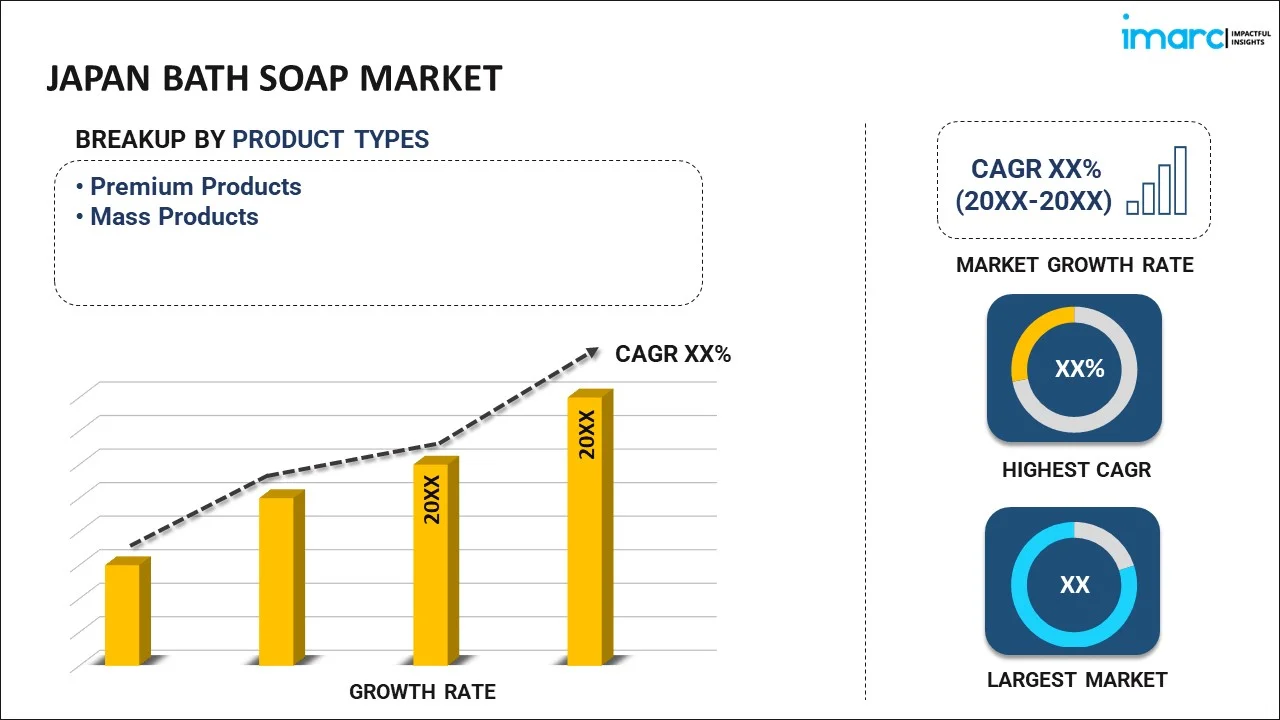
Japan Bath Soap Market Report by Product Type (Premium Products, Mass Products), Form (Solid Bath Soaps, Liquid Bath Soaps), Distribution Channel (Supermarkets and Hypermarkets, Convenience Stores, Pharmacies, Specialty Stores, Online, and Others), and Region 2025-2033
Market Overview:
The Japan bath soap market size reached USD 1.53 Billion in 2024. Looking forward, IMARC Group expects the market to reach USD 1.84 Billion by 2033, exhibiting a growth rate (CAGR) of 2.1% during 2025-2033.
|
Report Attribute
|
Key Statistics
|
|---|---|
|
Base Year
|
2024
|
|
Forecast Years
|
2025-2033
|
|
Historical Years
|
2019-2024
|
|
Market Size in 2024
|
USD 1.53 Billion |
|
Market Forecast in 2033
|
USD 1.84 Billion |
| Market Growth Rate 2025-2033 | 2.1% |
Bath soaps are cleansing products made from a combination of alkalis, such as sodium hydroxide (NaOH) and potassium hydroxide (KOH). They are commercially available in bar and liquid forms. Bath soaps are produced through the saponification process, wherein caustic lye is combined with oil to cause a chemical reaction that breaks down the fats in acid chains. Some other ingredients include glycerin, animal or vegetable fats, propylene glycol, allantoin, sodium laureth sulfate (SLS), and triethanolamine. Bath soaps create lather that kills microorganisms by disorganizing their membrane bilayer. It also emulsifies oils that enable dirt to detach from the skin, thereby assisting in unclogging pores, removing dirt and debris, and conditioning the skin.
Japan Bath Soap Market Trends:
Changing lifestyles and rising pollution levels represent the key factors that are driving the Japan bath soap market growth. This, in turn, is escalating the demand for new product variants that protect the skin against pollutants and keep the skin healthy. Additionally, strong income levels have enabled consumers to afford premium products infused with essential oils and fragrances to provide a spa-like experience, which is supporting the market growth. Apart from this, key players are adopting micro-biome and biotechnology to formulate high-performance bath soaps with enhanced moisturizing capabilities and dermatological benefits, which is acting as a growth-inducing factor. Moreover, the increasing hygiene concerns, especially amidst the coronavirus disease (COVID-19) outbreak, have intensified the need for germ-protecting, therapeutic, and antiseptic bath soaps, which is creating a positive outlook for the market.
Key Market Segmentation:
IMARC Group provides an analysis of the key trends in each segment of the Japan bath soap market report, along with forecasts at the country and regional levels from 2025-2033. Our report has categorized the market based on product type, form and distribution channel.
Breakup by Product Type:

- Premium Products
- Mass Products
Breakup by Form:
- Solid Bath Soaps
- Liquid Bath Soaps
Breakup by Distribution Channel:
- Supermarkets and Hypermarkets
- Convenience Stores
- Pharmacies
- Specialty Stores
- Online
- Others
Breakup by Region:

- Kanto Region
- Kinki Region
- Central/ Chubu Region
- Kyushu-Okinawa Region
- Tohoku Region
- Chugoku Region
- Hokkaido Region
- Shikoku Region
Competitive Landscape:
The competitive landscape of the industry has also been examined along with the profiles of the key players.
Report Coverage:
| Report Features | Details |
|---|---|
| Base Year of the Analysis | 2024 |
| Historical Period | 2019-2024 |
| Forecast Period | 2025-2033 |
| Units | Billion USD |
| Segment Coverage | Product Type, Form, Distribution Channel, Region |
| Region Covered | Kanto Region, Kinki Region, Central/ Chubu Region, Kyushu-Okinawa Region, Tohoku Region, Chugoku Region, Hokkaido Region, Shikoku Region |
| Customization Scope | 10% Free Customization |
| Post-Sale Analyst Support | 10-12 Weeks |
| Delivery Format | PDF and Excel through Email (We can also provide the editable version of the report in PPT/Word format on special request) |
Key Questions Answered in This Report:
- How has the Japan bath soap market performed so far and how will it perform in the coming years?
- What has been the impact of COVID-19 on the Japan bath soap market?
- What are the key regional markets?
- What is the breakup of the market based on the product type?
- What is the breakup of the market based on the form?
- What is the breakup of the market based on the distribution channel?
- What are the various stages in the value chain of the industry?
- What are the key driving factors and challenges in the industry?
- What is the structure of the Japan bath soap market and who are the key players?
- What is the degree of competition in the industry?
Need more help?
- Speak to our experienced analysts for insights on the current market scenarios.
- Include additional segments and countries to customize the report as per your requirement.
- Gain an unparalleled competitive advantage in your domain by understanding how to utilize the report and positively impacting your operations and revenue.
- For further assistance, please connect with our analysts.
 Inquire Before Buying
Inquire Before Buying
 Speak to an Analyst
Speak to an Analyst
 Request Brochure
Request Brochure
 Request Customization
Request Customization




.webp)




.webp)












